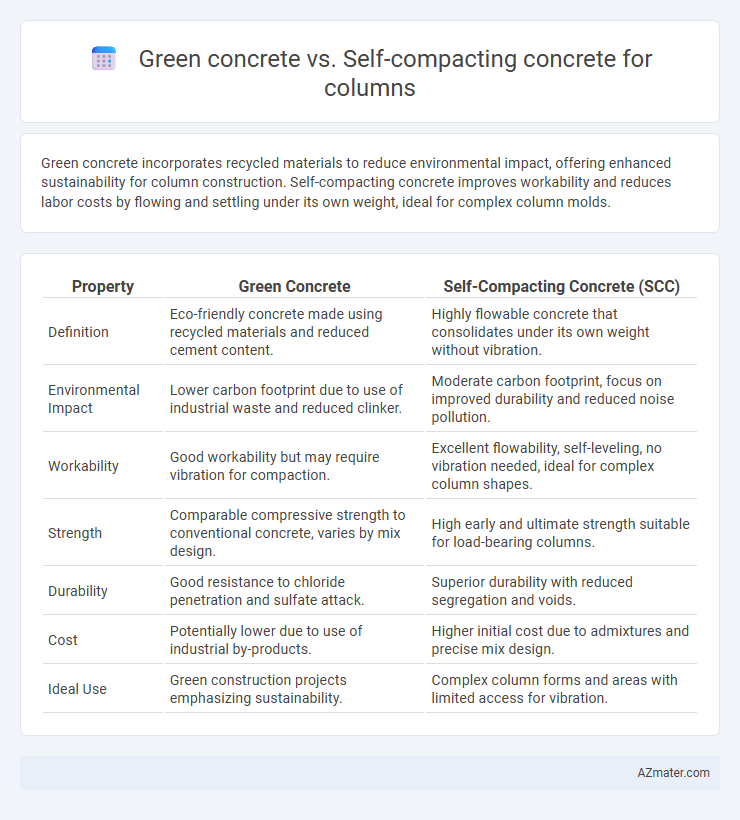Green concrete incorporates recycled materials to reduce environmental impact, offering enhanced sustainability for column construction. Self-compacting concrete improves workability and reduces labor costs by flowing and settling under its own weight, ideal for complex column molds.
Table of Comparison
| Property | Green Concrete | Self-Compacting Concrete (SCC) |
|---|---|---|
| Definition | Eco-friendly concrete made using recycled materials and reduced cement content. | Highly flowable concrete that consolidates under its own weight without vibration. |
| Environmental Impact | Lower carbon footprint due to use of industrial waste and reduced clinker. | Moderate carbon footprint, focus on improved durability and reduced noise pollution. |
| Workability | Good workability but may require vibration for compaction. | Excellent flowability, self-leveling, no vibration needed, ideal for complex column shapes. |
| Strength | Comparable compressive strength to conventional concrete, varies by mix design. | High early and ultimate strength suitable for load-bearing columns. |
| Durability | Good resistance to chloride penetration and sulfate attack. | Superior durability with reduced segregation and voids. |
| Cost | Potentially lower due to use of industrial by-products. | Higher initial cost due to admixtures and precise mix design. |
| Ideal Use | Green construction projects emphasizing sustainability. | Complex column forms and areas with limited access for vibration. |
Introduction to Green Concrete and Self-Compacting Concrete
Green concrete incorporates industrial by-products like fly ash and slag to reduce carbon emissions and enhance sustainability in construction. Self-compacting concrete (SCC) is designed for high fluidity, allowing it to flow and fill formwork without mechanical vibration, ideal for densely reinforced columns. Both types improve construction quality but target different performance and environmental benefits in column applications.
Key Material Components and Mix Design
Green concrete incorporates industrial by-products like fly ash, slag, and recycled aggregates to reduce environmental impact while maintaining adequate strength and durability for columns. Self-compacting concrete (SCC) features a high powder content, superplasticizers, and viscosity-modifying agents to ensure flowability and void-free filling without mechanical compaction, optimizing structural integrity in columns. The mix design of green concrete emphasizes sustainable materials and reduced cement content, whereas SCC focuses on rheological properties and particle packing to achieve self-leveling characteristics.
Sustainable Benefits of Green Concrete
Green concrete significantly enhances sustainability in column construction by utilizing recycled materials like fly ash and slag, reducing carbon emissions compared to traditional concrete mixes. It contributes to lower embodied energy and improved environmental performance, supporting green building certifications and long-term durability. Green concrete also promotes resource conservation and waste reduction, making it an eco-friendly alternative to self-compacting concrete for structural columns.
Workability and Flow Characteristics of Self-Compacting Concrete
Self-compacting concrete (SCC) exhibits superior workability and flow characteristics compared to green concrete, enabling it to fill complex column formworks without mechanical vibration. SCC's high fluidity, achieved through optimized mix designs that include superplasticizers and viscosity-modifying agents, ensures uniform consolidation and minimization of voids and honeycombing. In contrast, green concrete typically requires compaction efforts and may face challenges in maintaining consistent flow, affecting the quality of column structures.
Strength and Durability Performance Comparison
Green concrete, incorporating recycled materials and supplementary cementitious components, offers comparable compressive strength to self-compacting concrete (SCC) when properly designed, but may exhibit slightly reduced early-age strength due to pozzolanic reactions. Self-compacting concrete demonstrates superior flowability and uniform consolidation in columns, leading to enhanced microstructure density and higher long-term durability, minimizing voids and permeability. Durability performance of green concrete depends on material quality and mix design, whereas SCC consistently achieves improved resistance to chloride ingress, freeze-thaw cycles, and carbonation, making it preferable for high-performance structural columns.
Environmental Impact and Carbon Footprint
Green concrete reduces environmental impact by incorporating recycled materials and industrial by-products, significantly lowering carbon emissions compared to traditional mixes. Self-compacting concrete enhances construction efficiency and reduces waste but may involve higher cement content, leading to a relatively larger carbon footprint. For columns, green concrete offers superior sustainability benefits through minimized resource consumption and reduced greenhouse gas emissions.
Placement and Construction Efficiency in Columns
Green concrete offers enhanced sustainability through the use of recycled materials and reduces environmental impact, but it typically requires traditional placement methods that may slow construction. Self-compacting concrete (SCC) significantly improves placement efficiency in columns by flowing under its own weight, eliminating the need for vibration and allowing faster, more uniform filling around reinforcement. The superior workability and reduced labor of SCC make it ideal for complex column forms, accelerating construction schedules while maintaining structural integrity.
Cost Analysis and Economic Viability
Green concrete reduces overall project costs by utilizing recycled materials and industrial byproducts like fly ash and slag, lowering cement consumption and waste disposal expenses. Self-compacting concrete (SCC) demands higher material costs due to specialized admixtures and precise mix design but decreases labor and formwork costs by improving flowability and eliminating vibration. Economic viability depends on project scale and priorities, where green concrete favors sustainability-driven budgets and SCC suits projects requiring faster construction and higher quality finishes despite greater initial costs.
Applications and Limitations in Column Construction
Green concrete in column construction offers eco-friendly advantages by incorporating recycled materials and reducing carbon footprint, suitable for sustainable building projects but may have lower early strength and longer curing times. Self-compacting concrete provides excellent workability and fills complex column molds without vibration, ideal for intricate or congested reinforcement but can be costlier and requires precise mix design to avoid segregation. Choosing between them depends on project priorities like sustainability goals, structural requirements, and budget constraints.
Future Trends and Innovations in Column Concrete Technology
Green concrete and self-compacting concrete (SCC) continue to advance as key innovations in column technology, with future trends emphasizing sustainability and enhanced performance. Innovations in green concrete focus on increased use of industrial by-products, carbon capture methods, and bio-based additives to reduce carbon footprint while maintaining structural integrity. SCC technology is evolving with smart admixtures for improved flowability and strength, enabling faster, more efficient construction of complex column geometries without compromising durability.

Infographic: Green concrete vs Self-compacting concrete for Column
 azmater.com
azmater.com